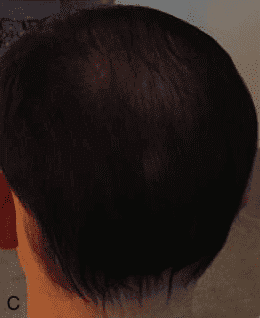
Don’t want to read the whole post?
Alopecia has been reversed through dietary changes. Scroll below for photos from a proper scientific study which prove it.
If you’re really pressed for time and can’t change your whole diet (or just don’t want to), focus on eating more of the three essential plant-based foods for alopecia:
jalapeño, soybeans and pumpkin seeds.
You might also like:
Nourishing Your Legs: The Best Diet for Varicose Veins
ABOUT ME
Be beauty. Be plant-based!
As a former Registered Nurse and avid plant-muncher, I’m in love with how simple plant-based foods make it so easy to be beautiful!

Sarah’s story
Sarah is in need of an alopecia diet plan. While a vibrant woman in her fifties, known for her easy confidence and love of life, Sarah’s hair has started disappearing. Recently she has noticed patchy hair loss, and feels embarrassed to talk about it. Instead her shame is casting a shadow on her usual confidence and her friends are starting to notice. Sarah hopes that eating better food could help, but she is anxious about not making her poor scalp health worse.
Determined to solve this problem, Sarah reads extensively for a good diet for alopecia. She discovered that a nutrient-rich plant-based diet could provide the greatest amount of essential nutrients her body needed to support hair growth. She learned that certain plant-based foods contained specific vitamins, minerals and protein that could promote healthy hair follicles and overall scalp health. Sarah felt hopeful.
Skip to: Nourish and Flourish: Three Essential Plant-based Foods for Alopecia
Armed with this knowledge, Sarah made a commitment to embrace a plant-based lifestyle but wanted to start with the easiest things first. So she began by adding specific hair-growth promoting foods to her current diet like pumpkin seeds to her breakfast oats and tasty jalapeños to spice up her lunch. Then she started making swaps such as soy and tempeh into dinner dishes before an abundance of fruits, vegetables, whole grains, legumes, nuts, and seeds into her daily meals.
Sarah’s plate eventually became a colourful assortment of nature’s beautiful foods, brimming with vitamins, minerals, and antioxidants. The abundance of antioxidants in her plant-based meals helped combat inflammation and oxidative stress, which could contribute to loss of hair.
Skip to: I Love Meat, Do I Really Need to Eat Plant-based?

Sometimes Sarah missed her favourite meat-based meals. Still, she decided again to stay focused on foods known to benefit hair health. Sarah ensured her diet was rich in plant-based sources of iron, such as leafy greens, lentils, and tofu, as iron deficiency could contribute to hair loss. She also consumed foods containing biotin, like sweet potatoes, almonds, and avocados, as biotin deficiency was linked to brittle hair.
To further support her hair growth goals, Sarah included plant-based sources of omega-3 fatty acids, such as flax seeds, chia seeds, and walnuts. These healthy fats nourished her scalp and hair follicles, promoting strength and resilience.
Skip to: Vitamins and Minerals: Luscious Locks’ Best Friends

As Sarah continued her plant-based journey, she noticed positive changes in her overall well-being. She felt energised, her skin became clearer, and her digestion improved. Sarah realised that her plant-based diet not only provided the necessary nutrients for hair growth but also contributed to her body’s overall health and vitality.
But the most exciting and desired transformation was yet to come.
After several months of dedication to her plant-based diet, Sarah began to witness the fruits of her efforts—literally! Small patches of hair started to regrow on her scalp. Sarah’s confidence began to burst through again. She marveled at the resilience and healing power of her body.
Skip to: Does an alopecia diet plan really work?
While she felt physically and emotionally radiant on a fully-committed plant-based diet, it was difficult at times because her husband was still a meat eater. To prevent any future hair loss for the both of them, she has convinced him to share a Mediterranean diet with her, with lots of fresh herbs and raw vegetables where possible. This diet is easier for them both to stick to, and although most people don’t realise it, a Mediterranean diet is mostly plant-based anyway.
Sarah is back into her social life and enjoys spending time with her friends. She no longer feels self-conscious and her hair growth journey has became a symbol of resilience, strength, and the transformative potential of embracing a plant-based diet amongst her friends.
Androgenetic alopecia, commonly referred to as female pattern hair loss, is a type of alopecia that typically occurs later in life. It is more common in women over the age of 50, but it can also start earlier. If you’re ready to make some dietary changes for better scalp health and hair growth.
Does an Alopecia Diet Plan Really Work?
Yes! The food we eat influences hair growth. One way food might impact your hair is through the microbiome. People who have been given a fecal matter transplant to change their microbiome have experienced substantial hair growth afterwards.
See these photos below. In the first is a 20 year old man starting to lose his hair. In the second photo, he has lost most of his hair. Finally in the third photo, all his hair has grown back after a little over a year.



When it comes to voluminous hair, it looks like good gut bacteria plays an important role.
This is great news, because you have control over what you eat (it’s also much easier and safe than having a fecal matter transplant).
Nourish to flourish: 3 essential plant-based foods for your alopecia diet plan
On other websites you will see a general list of foods that are recommended for an alopecia diet plan. Unfortunately they don’t state how much you need to eat or how well these foods actually work. That is, I couldn’t tell if they were backed by sound science.
So I kept looking.
Luckily, I found some good evidence. One great research study on the effect of certain foods on human hair growth shares very specific recommendations which researchers found to have a real impact on hair health:
- one quarter of a fresh jalapeño (for the capsaicin) a day
- 3/4 cup of tempeh or soybeans day
Try to avoid soy nuts though as they are dry-roasted at high temperatures. This causes the formation of advanced glycation end-products which is a fancy way of saying the high temperature makes the soy nuts pro-ageing. You don’t want to end up solving hair loss by creating wrinkles instead.
If you don’t like jalapeños then cayenne pepper is another source of capsaicin. However I’m not sure how much would be the equivalent of a quarter jalapeño.
Another research study found that pumpkin seeds can also increased hair growth. How many pumpkin seeds do you need to eat a day? Just two and a half.
In this study, after six months hair volume increased by 40%.
I Love Meat, Do I Really Need to Eat Plant-Based?
It can feel daunting to ‘give up’ meat. You definitely don’t want an alopecia diet plan that is so restrictive you can’t do it. However, alopecia, whether caused by auto immune diseases or adrogenetic factors, can be even more of a challenge than avoiding meat. Meanwhile, a fully plant-based diet is the best diet plan for nourishing your hair follicles, boosting your immune system, and promoting hair regrowth.
With a little planning and creativity, it becomes easier to make the small dietary changes required so that plants easily become a part of your healthy diet. Explore delicious plant-based recipes, experiment with new flavours, and embrace the incredible variety of ingredients available to you. Your taste buds and your hair will thank you!
My recommendation is to start small (two and half pumpkin seeds small!) and build from there. Feel free to load up on your favourite fruits and vegetables. Your scalp and hair don’t need you to be perfect or adhere completely to a rigid diet plan. They just need you to eat some more plants.
And then a few more.
Are you worried that eating plants will make you gain weight? Don’t worry anymore with: Plant-Based Perks: Weight-Loss Made Easy
Vitamins and Minerals: Luscious Locks’ Best Friends
Vitamin a, vitamin e, vitamin c and vitamin b, along with folic acid, are key players in maintaining a healthy scalp and stimulating hair regrowth. Luckily, you’ll find an abundance of these vitamins and other essential nutrients in plant-based sources.
Vitamin E
Vitamin E is an antioxidant that helps improve scalp circulation and promotes hair growth. Plant-based sources of vitamin E include:
- Nuts and seeds: Almonds, sunflower seeds, and hazelnuts.
- Avocado.
- Spinach and other leafy green vegetables.
- Vegetable oils like olive oil and sunflower oil.
Vitamin C
This vitamin aids in the absorption of iron and promotes collagen synthesis, which is vital for hair strength. Plant-based sources of vitamin C include:
- Citrus fruits: Oranges, lemons, and grapefruits.
- Berries: Strawberries, blueberries, and raspberries.
- Kiwi fruit.
- Leafy green vegetables like broccoli and Brussels sprouts.
Biotin
Biotin, also known as vitamin B7, plays a crucial role in hair health. Plant-based sources of biotin include:
- Almonds and other nuts.
- Legumes, such as peanuts and lentils.
- Whole grains, including oats and brown rice.
- Leafy green vegetables like spinach and kale.
Iron
Iron deficiency can lead to hair loss, so it’s important to consume enough iron-rich foods. Plant-based sources of iron include:
- Dark leafy greens: Spinach, kale, and Swiss chard.
- Legumes: Lentils, chickpeas, and kidney beans.
- Seeds: Pumpkin seeds, sesame seeds, and hemp seeds.
- Dried fruits: Apricots, raisins, and figs.
Promote hair growth with plant-based protein power
Protein is the building block of hair. Therefore an alopecia diet plan requires that you get enough protein for healthy hair regrowth. While red meat and dairy products are often hailed as the best sources of protein, plant-based protein is also just as effective. Even better, they are high in fibre and nutrients in general, which means eating more plant-based foods for your haircare will also help the health of your entire body.
Plant-based protein-rich foods include:
- Legumes: Lentils, chickpeas, black beans, and soybeans.
- Nuts and seeds: Almonds, walnuts, chia seeds, and flaxseeds (all good fats)
- Whole grains: Quinoa, brown rice, oats, and whole wheat.
These can help you improve your luscious locks.
Plant-based: Your alopecia diet plan
Inflammation can wreak havoc on your immune system and disrupt hair growth. By incorporating foods with anti-inflammatory properties into your diet, you can create a harmonious environment for your hair follicles to thrive.
Compared to lean meat, oily fish and other animal products, plant-based foods have 64 times the amount of antioxidants in them. Especially berries, colourful fruits and dark green leafy vegetables.
Now that is what you call a healthy diet.
Congratulations, you’re now equipped with the knowledge and tips to nurture healthy hair growth and combat alopecia with simple ways to start a plant-based alopecia diet plan. Remember, a healthy scalp and luscious hair are achievable with a healthy lifestyle, and the best way to achieve this is with the abundant nutrients found in plant-based foods. This way is also much more enjoyable than a fecal matter transplant!